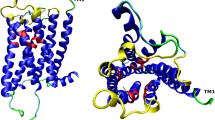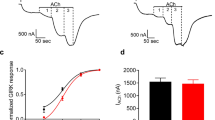Abstract
Mg2+-ions have been suspected to attenuate the inhibitory effect of allosteric modulators on the dissociation of orthosteric ligands from muscarinic M2 receptors. It was aimed to gain more insight into the molecular events underlying the effect of Mg2+. The interaction of Mg2+ with the allosteric model compounds W84 (hexane-1,6-bis [dimethyl-3’-phthalimidopropylammonium bromide]) and Chin3/6 (hexane-1,6-bis[dimethyl-3’-{4-oxo-2-phenyl-3,4-dihydro-2H-quinazolin-1-yl}propylammonium bromide]) was studied in porcine heart muscarinic receptors, the primary binding site of which was occupied by the ligand [3H]N-methylscopolamine ([3H]NMS). The incubation buffer was composed of 4 mM Na2HPO4 and 1 mM KH2PO4 (pH 7.4, 23°C). The retardation of [3H]NMS dissociation (control t1/2 = 5.6 min) induced by the allosteric test compounds was diminished by 3 mM Mg2+ to a greater extent than to be expected with regard to its contribution to the ionic strength of the buffer solution. Concentration-effect curves for the allosteric retardation of [3H]NMS dissociation by W84 (half maximal effective concentration EC0.5 = 24 nM in the absence of Mg2+) and by Chin3/6 (EC0.5 = 28 nM) were shifted by Mg2+ to the right in a parallel fashion. The curve-shift was compatible with a competitive interplay between Mg2+ and the modulators. The pK b-values as a measure of the antagonistic potency of Mg2+, however, differed depending on the modulator, i.e. pK b = 3.4 with W84 and pK b = 2.8 with Chin3/6. Mg2+ itself was capable of slowing the dissociation of [3H]NMS; the maximal retardation of [3H]NMS dissociation was about 3fold, the concentration-effect relationship was compatible with a two-site model using the above-mentioned pK b-values as affinity constants. Since the equilibrium-binding of [3H]NMS remained unchanged up to a Mg2+-concentration of 3 mM, the cation appears to inhibit the association and dissociation of [3H]NMS to the same extent in this concentration range. Taken together, the findings indicate that Mg2+ may bind to the allosteric region of muscarinic M2 receptors and that more than one site is involved in this interaction. The sites of action may represent divalent cation binding sites.
Similar content being viewed by others
Author information
Authors and Affiliations
Additional information
Received: 1 October 1997 / Accepted: 20 January 1998
Rights and permissions
About this article
Cite this article
Burgmer, U., Schulz, U., Tränkle, C. et al. Interaction of Mg2+ with the allosteric site of muscarinic M2 receptors. Naunyn-Schmiedeberg's Arch Pharmacol 357, 363–370 (1998). https://doi.org/10.1007/PL00005180
Issue Date:
DOI: https://doi.org/10.1007/PL00005180




